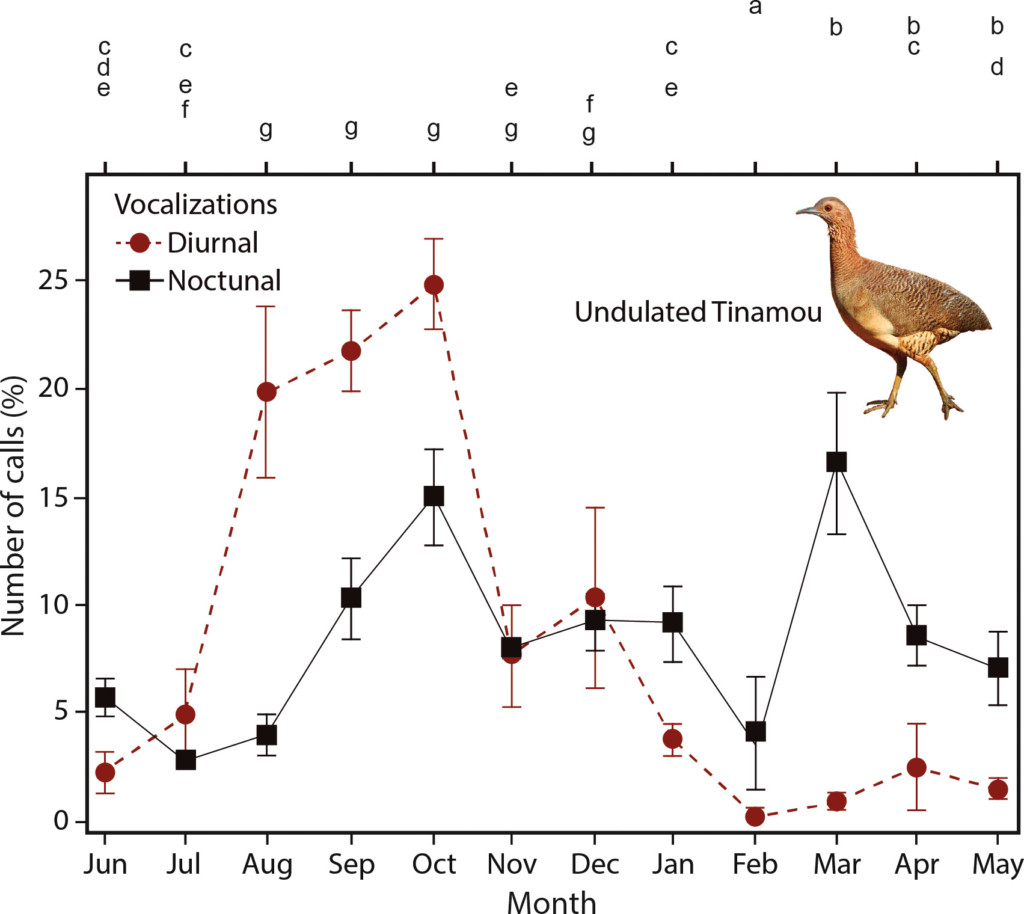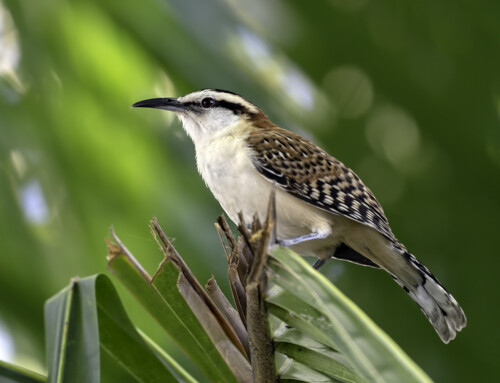 LINKED PAPER
LINKED PAPER
Nocturnal vocal behaviour of the diurnal Undulated Tinamou (Crypturellus undulatus) is associated with temperature and moon phase. Pérez‐Granados, C. & Schuchmann, K. L. 2021. IBIS. DOI: 10.1111/ibi.12909. VIEW
During dusk and dawn, the Undulated Tinamou (Crypturellus undulatus) produces a distinctive call, composed of three notes. Although this species is mostly diurnal, researchers noticed that it also vocalizes at night (Pérez-Granados et al. 2020). What could be the function of these nightly calls? In a review paper on nocturnal bird vocalizations, Van La (2012) proposed several hypotheses. Calling at night might be related to finding potential partners (‘mate attraction hypothesis’) or birds might use these calls to extend their territories after the sun sets (‘territory defense hypothesis’). Sound travels better at lower temperatures, so birds might communicate better during the night when temperatures drop (‘enhanced sound transmission hypothesis’). Several functions are thus possible, but which of these hypotheses best explains the nightly calls of the Undulated Tinamou?
Breeding season
To answer this question, Cristian Pérez-Granados and Karl-Ludwig Schuchmann travelled to the Brazilian Pantanal and build three acoustic monitoring stations. From 8 June 2015 to 31 May 2016, several sound recorders monitored the nightly calls of numerous bird species, including the Undulated Tinamou. Analyses of the recordings revealed that the Undulated Tinamou does indeed call at night. In fact, the number of calls even increased during the night. In addition, the tinamous were most active on moonlight nights (similar to other bird species, Penteriani et al. 2010). On a longer timescale, vocal activity was highest during the months of September and October, which coincides with the breeding season of these birds. This seasonality suggests that nightly calls might play a role in mate attraction or territory defense.

Figure 1. The vocal activity of the Undulated Tinamou peaked during the months September and October, both for diurnal (red) and nocturnal (black) calls.
Air temperature
The researchers reported no relationship between the number of nocturnal calls and the minimum air temperature. This result indicates that the ‘enhanced sound transmission hypothesis’ is probably not applicable to the Undulated Tinamou. Moreover, enhanced sound transmission may be more relevant for birds that call in open habitats, while tinamous tend to occur in closed forests (Slabbekoorn et al. 2002). All in all, the findings of this study point to a role in reproductive behavior for the nightly calls. Further research is needed to assess the breeding status of the calling birds and provide a direct link between these vocalizations and mate choice. However, the nightly call of the tinamou has become a bit less mysterious.
References
La, V.T. (2012). Diurnal and nocturnal birds vocalize at night: a review. Condor 114: 245– 257. VIEW
Penteriani, V., Delgado, M.M., Campioni, L. & Lourenço, R. (2010). Moonlight makes owls more chatty. PLoS One 5: e8696. VIEW
Pérez-Granados, C., Schuchmann, K.L. & Marques, M.I. (2020). Vocal behavior of the Undulated Tinamou (Crypturellus undulatus) over an annual cycle in the Brazilian Pantanal: new ecological information. Biotropica 52: 165– 171. VIEW
Slabbekoorn, H., Ellers, J. & Smith, T.B. (2002). Birdsong and sound transmission: the benefits of reverberations. Condor 104: 564– 573. VIEW
Image credits
Top right: Undulated Tinamou (Crypturellus undulatus) | Blake Matheson | CC BY-SA 2.0 Flickr
Blog posts express the views of the individual author(s) and not those of the BOU.
If you want to write about your research in #theBOUblog, then please see here




